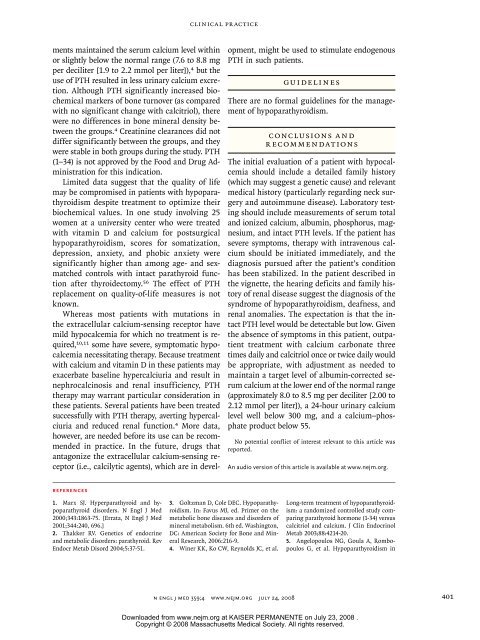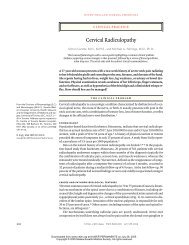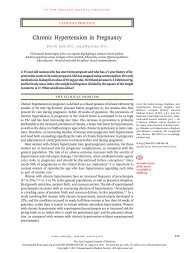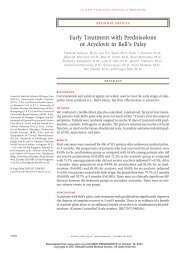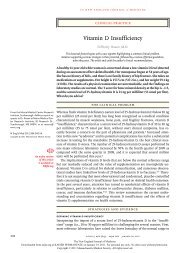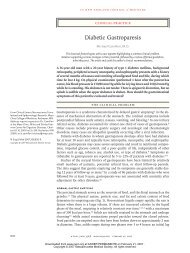Hypoparathyroidism - Q-Notes for Adult Medicine
Hypoparathyroidism - Q-Notes for Adult Medicine
Hypoparathyroidism - Q-Notes for Adult Medicine
Create successful ePaper yourself
Turn your PDF publications into a flip-book with our unique Google optimized e-Paper software.
clinical practice<br />
ments maintained the serum calcium level within<br />
or slightly below the normal range (7.6 to 8.8 mg<br />
per deciliter [1.9 to 2.2 mmol per liter]), 4 but the<br />
use of PTH resulted in less urinary calcium excretion.<br />
Although PTH significantly increased biochemical<br />
markers of bone turnover (as compared<br />
with no significant change with calcitriol), there<br />
were no differences in bone mineral density between<br />
the groups. 4 Creatinine clearances did not<br />
differ significantly between the groups, and they<br />
were stable in both groups during the study. PTH<br />
(1–34) is not approved by the Food and Drug Administration<br />
<strong>for</strong> this indication.<br />
Limited data suggest that the quality of life<br />
may be compromised in patients with hypoparathyroidism<br />
despite treatment to optimize their<br />
biochemical values. In one study involving 25<br />
women at a university center who were treated<br />
with vitamin D and calcium <strong>for</strong> postsurgical<br />
hypoparathyroidism, scores <strong>for</strong> somatization,<br />
depression, anxiety, and phobic anxiety were<br />
significantly higher than among age- and sexmatched<br />
controls with intact parathyroid function<br />
after thyroidectomy. 56 The effect of PTH<br />
replacement on quality-of-life measures is not<br />
known.<br />
Whereas most patients with mutations in<br />
the extracellular calcium-sensing receptor have<br />
mild hypocalcemia <strong>for</strong> which no treatment is required,<br />
10,11 some have severe, symptomatic hypocalcemia<br />
necessitating therapy. Because treatment<br />
with calcium and vitamin D in these patients may<br />
exacerbate baseline hypercalciuria and result in<br />
nephrocalcinosis and renal insufficiency, PTH<br />
therapy may warrant particular consideration in<br />
these patients. Several patients have been treated<br />
successfully with PTH therapy, averting hypercalciuria<br />
and reduced renal function. 4 More data,<br />
however, are needed be<strong>for</strong>e its use can be recommended<br />
in practice. In the future, drugs that<br />
antagonize the extracellular calcium-sensing receptor<br />
(i.e., calcilytic agents), which are in development,<br />
might be used to stimulate endogenous<br />
PTH in such patients.<br />
Guidelines<br />
There are no <strong>for</strong>mal guidelines <strong>for</strong> the management<br />
of hypoparathyroidism.<br />
Conclusions and<br />
Recommendations<br />
The initial evaluation of a patient with hypocalcemia<br />
should include a detailed family history<br />
(which may suggest a genetic cause) and relevant<br />
medical history (particularly regarding neck surgery<br />
and autoimmune disease). Laboratory testing<br />
should include measurements of serum total<br />
and ionized calcium, albumin, phosphorus, magnesium,<br />
and intact PTH levels. If the patient has<br />
severe symptoms, therapy with intravenous calcium<br />
should be initiated immediately, and the<br />
diagnosis pursued after the patient’s condition<br />
has been stabilized. In the patient described in<br />
the vignette, the hearing deficits and family history<br />
of renal disease suggest the diagnosis of the<br />
syndrome of hypoparathyroidism, deafness, and<br />
renal anomalies. The expectation is that the intact<br />
PTH level would be detectable but low. Given<br />
the absence of symptoms in this patient, outpatient<br />
treatment with calcium carbonate three<br />
times daily and calcitriol once or twice daily would<br />
be appropriate, with adjustment as needed to<br />
maintain a target level of albumin-corrected serum<br />
calcium at the lower end of the normal range<br />
(approximately 8.0 to 8.5 mg per deciliter [2.00 to<br />
2.12 mmol per liter]), a 24-hour urinary calcium<br />
level well below 300 mg, and a calcium–phosphate<br />
product below 55.<br />
No potential conflict of interest relevant to this article was<br />
reported.<br />
An audio version of this article is available at www.nejm.org.<br />
References<br />
1. Marx SJ. Hyperparathyroid and hypoparathyroid<br />
disorders. N Engl J Med<br />
2000;343:1863-75. [Errata, N Engl J Med<br />
2001;344:240, 696.]<br />
2. Thakker RV. Genetics of endocrine<br />
and metabolic disorders: parathyroid. Rev<br />
Endocr Metab Disord 2004;5:37-51.<br />
3. Goltzman D, Cole DEC. <strong>Hypoparathyroidism</strong>.<br />
In: Favus MJ, ed. Primer on the<br />
metabolic bone diseases and disorders of<br />
mineral metabolism. 6th ed. Washington,<br />
DC: American Society <strong>for</strong> Bone and Mineral<br />
Research, 2006:216-9.<br />
4. Winer KK, Ko CW, Reynolds JC, et al.<br />
Long-term treatment of hypoparathyroidism:<br />
a randomized controlled study comparing<br />
parathyroid hormone (1-34) versus<br />
calcitriol and calcium. J Clin Endocrinol<br />
Metab 2003;88:4214-20.<br />
5. Angelopoulos NG, Goula A, Rombopoulos<br />
G, et al. <strong>Hypoparathyroidism</strong> in<br />
n engl j med 359;4 www.nejm.org july 24, 2008 401<br />
Downloaded from www.nejm.org at KAISER PERMANENTE on July 23, 2008 .<br />
Copyright © 2008 Massachusetts Medical Society. All rights reserved.


